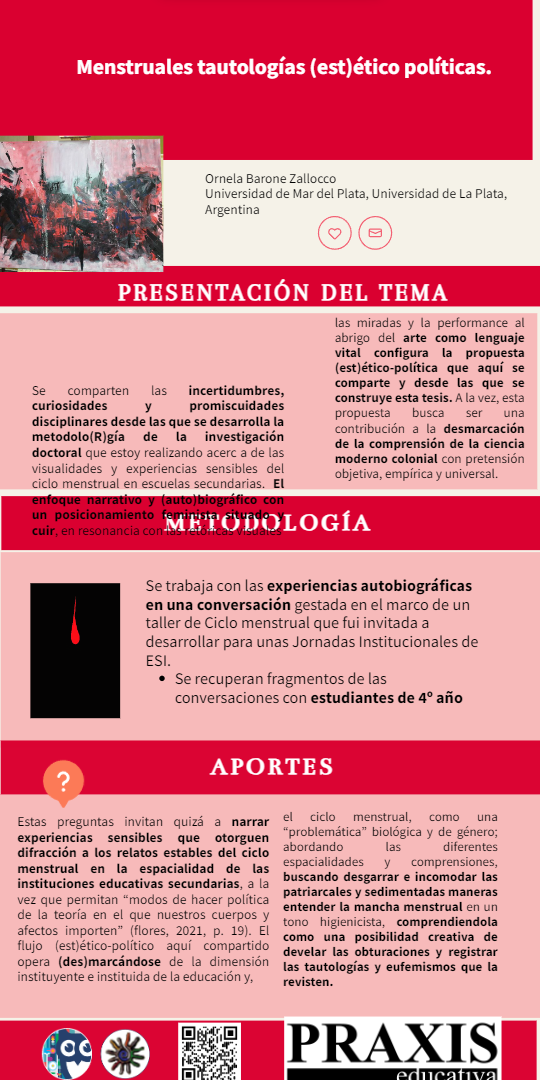Menstruales tautologías (est)ético-políticas
DOI:
https://doi.org/10.19137/praxiseducativa-2023-270313Palabras clave:
visualidad; ciclo menstrual; investigación basada en artes; performance; pedagogía cuirResumen
En el presente artículo, se comparten las incertidumbres, curiosidades y promiscuidades disciplinares desde las que se desarrolla la metodolo(R)gía de la investigación doctoral que estoy realizando acerca de las visualidades y experiencias sensibles del ciclo menstrual en escuelas secundarias. El enfoque narrativo y (auto)biográfico con un posicionamiento feminista situado y cuir, en resonancia con las retóricas visuales, las miradas y la performance al abrigo del arte como lenguaje vital configura la propuesta (est)ético-política que aquí se comparte y desde las que se construye esta tesis. A la vez, esta propuesta busca ser una contribución a la desmarcación de la comprensión de la ciencia moderno colonial con pretensión objetiva, empírica y universal.
Descargas
Citas
Ahmed, S. (2019). Fenomenología Queer: orientaciones, objetos, otros. Bellaterra Editorial.
Alcázar, J. (2014). Performance. Un arte del yo. Autobiografía, cuerpo e identidad. Siglo XXI.
Amícola, J. (2007). Autobiografía como autofiguración: Estrategias discursivas del yo y cuestiones de género. Beatriz Viterbo.
Anzaldúa, G. (2021). Luz en lo oscuro. Ed. Hekht.
Bal, M. (2016). Tiempos trastornados: Análisis, historias y políticas de la mirada. Ediciones Akal.
Barone Zallocco, O. (2019). Lo cuir de la menstruación en las aulas. Rev. de Educación UNMdP, (18), 233-250.
Barone Zallocco, O. (2021). Teñir la ESI de rojo menstrual. Praxis educativa, 25(1), 1-16. https://dx.doi.org/10.19137/praxiseducativa-2021-250117
Calafell Sala, N. (2007). Textualidades femeninas: la auto(bio)grafía en Victoria Ocampo, Norah Lange y Alejandra Pizarnik. Extravío. Revista electrónica de literatura comparada, (2). Universidad Autónoma de Barcelona.
Coccia, E. (2017). La vida de las plantas. Una metafísica de la mixtura. Miño y Dávila.
Denzin, N. K. y Lincoln, Y. S. (Eds.). (2015). Métodos de recolección y análisis de datos: manual de investigación cualitativa. GEDISA.
Didi-Huberman, G. (1997). Lo que vemos, lo que nos mira. Manantial.
Finley, S. (2015). Investigación con base en las artes. En K. N. Denzin e Y. S. Lincoln, Métodos de recolección y análisis de datos. Gedisa.
Fisher, M. (2018). Lo raro y lo espeluznante. Ediciones Alpha Decay, S.A.
flores, v. (2018). Esporas de indisciplina. Pedagogías trastornadas y metodologías queer. En fabi tron (Ed.), Pedagogías Transgresoras II (pp. 141 -208). Bocavulvaria ediciones.
flores, v. (2019). Una lengua cosida de relámpagos. Hekht.
flores, v. (2021). Romper el corazón del mundo: modos fugitivos de hacer teoría. La Libre Editora.
García-Huidobro Munita, R. (2016). La narrativa como método desencadenante y producción teórica en la investigación cualitativa. EMPIRIA. Revista de Metodología de las Ciencias Sociales, (34), 155-177.
Groys, B. (2018). Volverse público. Las transformaciones del arte en el ágora contemporánea. Caja negra.
Guasch, A. M. (2005). Doce reglas para una Nueva Academia: La <> y los estudios audiovisuales. En J. L. Brea (Ed.), Estudios visuales (pp. 59-74). Ediciones Akal.
Haraway, D. (2021). Testigo_Modesto@Segundo_MIlenio.HombreHembra Ⓒ_Conoce_ OncoRataⓇ. Rara Avis.
Haudricourt, A. (2019). El cultivo de los gestos. Cactus.
Hernández Hernández, F. (2008). La investigación basada en las artes. Propuestas para repensar la investigación en educación. Educatio Siglo XXI, (26), 85-118.
Laguna González, M. (2005). Escritura autobiográfica. LINDARAJA. Revista de estudios interdisciplinares, (3). Foro universitario de Realidad y ficción.
Lopes Louro, G. (2018). Los estudios feministas, los estudios gays y lésbicos y la teoría cuir como políticas de conocimiento. En G. Herczeg (Comp.), Pedagogías Transgresoras. Bocavulvaria.
Masson, L. (2017). Epistemología rumiante. Pensaré cartoneras.
Nussbaum, M. C. (2012). El ocultamiento de lo humano. Repugnancia, vergüenza y ley. Katz Editores.
Passeggi, M. D. C. (2015). Narrativa, experiencia y reflexión autobiográfica: por una epistemología del sur en educación. En G. J. Murillo Arango (Ed.), Narrativas de experiencia en educación y pedagogía de la memoria. CLACSO.
Pérez, M. (2016). Teoría Queer, ¿para qué? ISEL, 5, 184-198.
Preciado, P. B. (2020). Yo soy el monstruo que os habla: informe para una academia de psicoanalistas. Anagrama.
Preciado, P. B. (2022). Dysphoria mundi. Anagrama.
Porta, L., Ramallo, F. y Aguirre, J. (2018). La expansión (auto)biográfica: Territorios habitados y sentidos desocultados en la investigación educativa. Interritórios Revista de Educação, 4(7), 164-183. Universidade Federal de Pernambuco.
Rebentisch, J. (2018). Estética de la instalación. Caja Negra.
Silverman, K. (2009). El umbral del mundo visible. Ediciones Akal.
Stengers, I. (2020). Pensar con whitehead. Editorial cactus.
Tarzibachi, E. (2017). Cosa de mujeres. Menstruación, género y poder. Sudamericana.
Whitehead, A. (2022). Modos de pensamiento. Cactus.

Descargas
Publicado
Número
Sección
Licencia
Nota de copyright
Comité Editorial Revista Praxis educativa:
Por la presente declaro que soy autor del artículo titulado (nombre del artículo), que el mismo es original y propio y que no fue publicado en ningún otro formato o soporte con anterioridad. Manifiesto conocer que la revista no me cobrará ningún tipo de tasa bajo ningún concepto, ni recibiré ningún tipo de compensación monetaria
Si el mismo fuera aceptado para su publicación en Praxis educativa, autorizo a la referida revista a publicarlo en forma digital y a publicitarlo en sus redes sociales.
Si el trabajo fuera publicado, adhiero a la licencia Creative Commons denominada “Atribución - No Comercial Compartir igual CC BY-NC-SA”, mediante la cual se permite copiar, reproducir, distribuir, comunicar públicamente la obra y generar obras derivadas, siempre y cuando se cite y reconozca al autor original. Esta licencia se utiliza desde septiembre 2018. En 2016 se adhirió a CC BY NC ND 4.0; y en años 2017 y 2018 (enero -agosto) CC BY NC 4.0..
Esta licencia CC BY-NC-SA Compartir igual no permite, sin embargo, utilizar la obra con fines comerciales. Como autor la revista podré establecer acuerdos adicionales para la distribución no exclusiva de la versión de la obra publicada en la revista me permite el autoarchivo de los artículos publicados, en su versión post-print, en repositorios institucionales, temáticos, páginas web personales o cualquier otro uso pertinente. con el reconocimiento de haber sido publicado primero en esta revista.
Praxis educativa adhiere a DORA (Declaration on Research Assessment) firmada en San Francisco, California, el 16 de diciembre de 2012, y a la Declaración de México (Declaración Conjunta LATINDEX - REDALYC - CLACSO - IBICT).














_(1)2.png)


3.png)










_(2).png)






2.jpg)
8.png)









